“Aquilo que começa e acaba é o ‘eu’ transitório. Aquilo que não tem origem nem fim é a consciência permanente ‘Eu sou Eu’.”
Don't wanna be here? Send us removal request.
Text

🌿🌹 MERRY CHRISTMAS🌹🌿 🌿🌹A HOLY CHRISTMAS🌹🌿
✨🌟✨ L. 95 Begin with saying this:
🕊️ I am one Self, united with my Creator, at one with every aspect of creation, and limitless in power and in peace. 🕊️
Your own acknowledgment you are one Self, united with your Father, is a call to all the world to be at one with you. To everyone you meet today, be sure to give the promise of today’s idea and tell him this:
🕊️ You are one Self with me, united with our Creator in this Self. I honor you because of What I am, and What He is, Who loves us both as One. 🕊️
✨🌟✨ L. 96 Wait patiently, and let Him speak to you about your Self, and what your mind can do, restored to It and free to serve Its Will. Begin with saying this:
🕊️ Salvation comes from my one Self. 🕊️ 🕊️ Its Thoughts are mine to use. 🕊️
Each time today you tell your frantic mind salvation comes from your one Self, you lay another treasure in your growing store. And all of it is given everyone who asks for it, and will accept the gift. Think, then, how much is given unto you to give this day, that it be given you!
✨🌟✨ L. 97 You are the spirit lovingly endowed with all your Father’s Love and peace and joy. You are the spirit which completes Himself, and shares His function as Creator. He is with you always, as you are with Him. Begin with saying this:
🕊️ Spirit am I, a holy Son of God, free of all limits, safe and healed and whole, free to forgive, and free to save the world. 🕊️
The Holy Spirit will be glad to carry your words around this aching world where pain and misery appear to rule. He will not overlook one open mind that will accept the healing gifts they bring, and He will lay them everywhere He knows they will be welcome. And they will increase in healing power each time someone accepts them as his thoughts, and uses them to heal. Listen for His assurance every time you speak the words He offers you today, and let Him tell your mind that they are true. Use them against temptation, and escape its sorry consequences if you yield to the belief that you are something else. The Holy Spirit gives you peace today. Receive His words, and offer them to Him.
~ ACIM - A Course in Miracles
✨✨✨✨✨✨✨✨✨✨✨✨✨✨✨ 🌿NOTHING REAL CAN BE THREATENED. 🌿NOTHING UNREAL EXISTS. 🌿HEREIN LIES THE PEACE OF GOD. ✨✨✨✨✨✨✨✨✨✨✨✨✨✨✨
2 notes
·
View notes
Text


🌿🌹 FELIZ NATAL🌹🌿 🌿🌹UM SANTO NATAL🌹🌿
𝘐𝘯 "UCEM - Um Curso Em Milagres"
✨🌟✨ L. 95 Começa dizendo:
🕊️ Eu sou um só Ser, unido ao meu Criador, em unidade com todos os aspetos da criação, e ilimitado em poder e paz. 🕊️
O teu próprio reconhecimento de que és um só Ser, unido ao teu Pai, é um chamado para o mundo todo estar em unidade contigo. Certifica-te de dar a promessa da ideia de hoje a todos aqueles que encontrares neste dia, dizendo-lhes:
🕊️ Tu és um único Ser comigo, estamos unidos ao nosso Criador nesse Ser. Eu te honro pelo Que eu sou, e pelo Que é Aquele Que nos ama como um só. 🕊️
✨🌟✨ L. 96 Espera pacientemente e deixa-O falar-te sobre o teu Ser e sobre o que a tua mente pode fazer restaurada a Ele e livre para servir à Sua Vontade. Começa dizendo:
🕊️ A salvação vem do meu único Ser. 🕊️ 🕊️ Os Seus pensamentos são meus para que eu os possa usar. 🕊️
A cada vez que disseres à tua mente frenética que a salvação vem do teu Ser, estás depositando mais um tesouro na tua reserva crescente. E ela é dada por inteiro a quem pedir e aceitar a dádiva. Pensa, então, no quanto te é dado para dar neste dia, para que seja dado a ti!
✨🌟✨ L. 97 Tu és o espírito amorosamente dotado de todo o Amor, da paz e da alegria do teu Pai. Tu és o espírito que completa a Ele Mesmo e que compartilha a Sua função como Criador. Ele está contigo sempre, assim como tu estás com Ele. Começa dizendo:
🕊️ Eu sou espírito, um Filho santo de Deus, livre de todos os limites, seguro, curado e íntegro, livre para perdoar e livre para salvar o mundo. 🕊️
O Espírito Santo ficará contente de carregar as tuas palavras através desse mundo sofredor, e as depositará em todos os lugares onde sabe que são bem-vindas. E elas aumentarão em seu poder de cura a cada vez que alguém as aceita como seus próprios pensamentos e as usa para curar.
Escuta a Sua confirmação a cada vez que disseres as palavras que Ele te oferece hoje e deixa-o dizer à tua mente que são verdadeiras. Usa-as contra a tentação e escapa das suas tristes consequências se cederes à crença de que és alguma outra coisa. Hoje o Espírito Santo te dá paz. Recebe as suas palavras e oferece-as a Ele.
~ UCEM - Um Curso Em Milagres
✨✨✨✨✨✨✨✨✨✨✨✨✨✨✨ 🌿NADA REAL PODE SER AMEAÇADO. 🌿NADA IRREAL EXISTE. 🌿NISSO ESTÁ A PAZ DE DEUS. ✨✨✨✨✨✨✨✨✨✨✨✨✨✨✨
4 notes
·
View notes
Text

TRANSCENDING CHRISTIANITY
The French Catholic monk Swami Abhishiktananda, the time he spent at Arunachala - leading to a deep enlightenment experience towards the end of his life.
He had darshan of Bhagavan in 1949, and in the early 1950s, he came back to Arunachala to spend time meditating in its caves. An account of his meeting with Bhagavan (who made a huge and very positive impression on him) and the months he spent meditating in the caves of Arunachala can be found in his book ‘The Secret of Arunachala’ which was published in the late 1970s, a few years after its author had passed away.
Before coming to India Swami Abhishiktananda had spent more than twenty years as a Benedictine monk in a French monastery, where he was known as Father Henri le Saux. After some time in India, he adopted the robes and lifestyle of a Hindu sannyasi and called himself ‘Swami Abhishiktananda’. Despite the change of outfit and name, for many years he clung tenaciously to the basic tenets of the Catholic faith that he had been brought up in, feeling that the highest Christian experience and teachings were superior to their Hindu counterparts.
In 1973 he had a heart attack on the streets of Rishikesh that left him unconscious and temporarily paralyzed. When he finally recovered his faculties, he instantly became aware that the Abhishiktananda who had held tightly to Catholic doctrine throughout his life had vanished, leaving just an impersonal experience of the underlying ‘I am’. This is how he wrote about it in letters to friends:
‘Who can bear the glory of transfiguration, of man's dying as transfigured; because what Christ is I AM! One can only speak of it after being awoken from the dead … .
‘It was a remarkable spiritual experience … While I was waiting on my sidewalk, on the frontier of the two worlds, I was magnificently calm, for I AM, no matter what in the world! I have found the GRAIL!’ (‘Swami Abhishiktananda’, by James Stuart, ISPCK, 1989, p. 346)
The finding of the grail was inextricably linked to losing all the previous concepts he had had about Christ and the Church. Commenting on this experience in the same book, he wrote:
‘So long as we have not accepted the loss of all concepts, all myths – of Christ, of the Church – nothing can be done.
’From this new experiential standpoint, he was able to say, from direct experience, that it was the ‘I’, rather than a collection of sectarian teachings and beliefs, that gave reality to God:
‘I really believe that the revelation of AHAM [“I”] is perhaps the central point of the Upanishads. And that is what gives access to everything; the “knowing” which reveals all “knowing”. God is not known, Jesus is not known, nothing is known outside this terribly solid AHAM that I am. From that alone all true teaching gets its value.’(‘Swami Abhishiktananda’, by James Stuart, ISPCK, 1989, p. 358)
In addition to writing several books that attempted to bridge the gap between Hinduism and Christianity, Abhishiktananda had been a regular contributor to seminars and conferences on the future development of Indian Christianity. After his great experience, he received an invitation to attend a Muslim gathering in France to give a Christian point of view. In declining the invitation, he revealed how all his old ideas had been swept away, and how he no longer felt able to expound a specifically Christian viewpoint:
‘The more I go [on], the less able I would be to present Christ in a way which would still be considered as Christian … For Christ is first an idea which comes to me from outside. Even more after my “beyond life/death experience” of 14.7 [.73] I can only aim at awakening people to what “they are”. Anything about God or the Word in any religion, which is not based on the deep “I” experience, is bound to be simple “notion”, not existential.
‘I am interested in no Christology at all. I have so little interest in a 'Word of God' which will awaken man within history … The Word of God comes from/to my own “present”; it is that very awakening which is my self-awareness. What I discover above all in Christ is his “I AM” … it is that I AM experience which really matters. Christ Is the very mystery “That I AM”, and in the experience and existential knowledge all Christology has disintegrated.’ (‘Swami Abhishiktananda’, by James Stuart, ISPCK, 1989, pp. 348-9)
Then, confirming that a lifetime’s convictions had been dropped, he went on to explain that the final Christian experience of ‘I am’ could not differ from its Hindu equivalent:
‘What would be the meaning of a “Christianity-coloured” awakening? In the process of awakening, all this coloration cannot but disappear … The coloration might vary according to the audience, but the essential goes beyond. The discovery of Christ’s I AM is the ruin of any Christian theology, for all notions are burned within the fire of experience … I feel too much, more and more, the blazing fire of this I AM in which all notions about Christ's personality, ontology, history, etc. have disappeared.’ (‘Swami Abhishiktananda’, by James Stuart, ISPCK, 1989, p. 349)
After a lifetime of meditation and research he had finally conceded that no explanation or experience could impinge on the fundamental reality, ‘I am’. Years before he had predicted that this standpoint would be the inevitable consequence of a full experience of ‘I am’:
‘Doctrines, laws, and rituals are only of value as signposts, which point the way to what is beyond them. One day in the depths of his spirit man cannot fail to hear the sound of the I am uttered by He-who-is. He will behold the shining of the Light whose only source is itself, is himself, is the unique Self … What place is then left for ideas, obligations or acts of worship of any kind whatever?’ (‘Saccidananda’ by Abhishiktananda, ISPCK, 1974, p. 46)
‘When the Self shines forth, the “I” that has dared to approach can no longer recognize its own self or preserve its own identity in the midst of that blinding light. It has, so to speak, vanished from its own sight. Who is left to be in the presence of Being itself. The claim of Being is absolute … All the later developments of the [Jewish] religion - doctrine, laws and worship – are simply met by the advaitin with the words originally revealed to Moses on Mount Horeb, “I am that I am”.’
(‘Saccidananda’ by Abhishiktananda, ISPCK, 1974, p. 45)
- David Godman's FB page: Arunachala Cave-Dwellers and Sadhus


#Bhagavan Sri Ramana Maharshi#Ramana Maharshi#Swami Abhishiktananda#Abhishiktananda#advaita#Arunachalam#Arunachala#christianity#Jesus Christ#David Godman
7 notes
·
View notes
Text
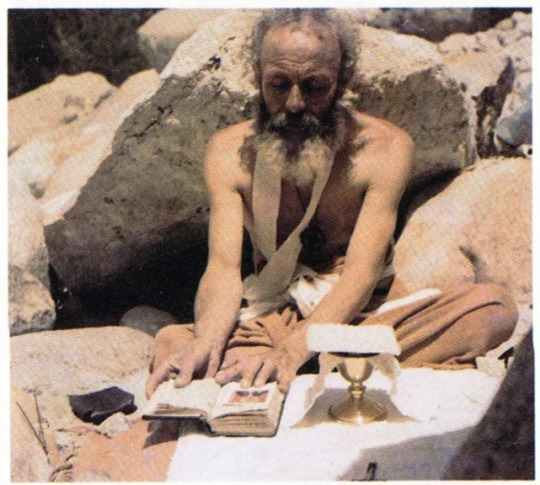
~ Swami Abhishiktananda ~
TRANSCENDENDO O CRISTIANISMO
O tempo que o monge católico francês, Swami Abhishiktananda, passou em Arunachala - levou-o a uma profunda experiência de iluminação no final da sua vida.
Recebeu o 'darshan' de Bhagavan em 1949 e, no início da década de 1950, regressou a Arunachala para passar algum tempo a meditar nas suas grutas. Um relato do seu encontro com Bhagavan (que lhe causou uma enorme e muito positiva impressão), e dos meses que passou a meditar nas grutas de Arunachala, pode ser encontrado no seu livro ‘O Segredo de Arunachala’, publicado no final da década de 1970, alguns anos após o falecimento do seu autor.
Antes de vir para a Índia, Swami Abhishiktananda passou mais de vinte anos como monge beneditino num mosteiro francês, onde era conhecido por Padre Henri le Saux. Depois de algum tempo na Índia, adotou as vestes e o estilo de vida de um 'sannyasi' hindu e auto-intitulou-se ‘Swami Abhishiktananda’. Apesar da mudança de roupa e de nome, durante muitos anos agarrou-se tenazmente aos princípios básicos da fé católica em que foi educado, sentindo que a mais elevada experiência e ensinamentos cristãos eram superiores aos seus homólogos hindus.
Em 1973 teve um ataque cardíaco nas ruas de Rishikesh que o deixou inconsciente e temporariamente paralisado. Quando finalmente recuperou as suas faculdades, tomou imediatamente consciência de que o Abhishiktananda que se tinha agarrado firmemente à doutrina católica ao longo da sua vida tinha desaparecido, deixando apenas uma experiência impessoal do subjacente “eu sou”. Foi assim que escreveu sobre isso em cartas a amigos:
'Quem pode suportar a glória da transfiguração, da morte do homem como transfigurado; porque o que Cristo é EU SOU! Só se pode falar disso depois de se ter acordado de entre os mortos… .
‘Foi uma experiência espiritual notável… Enquanto esperava na calçada do meu caminho, na fronteira dos dois mundos, fiquei magnificamente calmo, pois EU SOU, aconteça o que acontecer no mundo! Encontrei o GRAAL!’ (‘Swami Abhishiktananda’, por James Stuart, ISPCK, 1989, p. 346)
A descoberta do Graal esteve indissociavelmente ligada à perda de todos os conceitos anteriores que tinha sobre Cristo e a Igreja. Comentando esta experiência no mesmo livro, escreveu:
‘Enquanto não aceitarmos a perda de todos os conceitos, de todos os mitos – de Cristo, da Igreja – nada poderá ser feito.
'A partir deste novo ponto de vista experiencial, ele foi capaz de dizer, a partir da experiência direta, que foi o 'Eu', e não uma colecção de ensinamentos e crenças sectárias, que deu realidade a Deus:
‘Acredito verdadeiramente que a revelação de AHAM [“Eu”] é talvez o ponto central das Upanishads. E é isso que dá acesso a tudo; o “saber” que revela todo o “saber”. Deus não é conhecido, Jesus não é conhecido, nada se conhece fora deste AHAM terrivelmente sólido que eu sou. Só a partir disto todo o verdadeiro ensinamento obtém o seu valor.’(‘Swami Abhishiktananda’, por James Stuart, ISPCK, 1989, p. 358)
Para além de ter escrito vários livros que tentavam preencher a lacuna entre o hinduísmo e o cristianismo, Abhishiktananda contribuiu regularmente para seminários e conferências sobre o desenvolvimento futuro do cristianismo indiano. Depois da sua grande experiência, recebeu um convite para participar num encontro muçulmano em França para apresentar um ponto de vista cristão. Ao recusar o convite, revelou como todas as suas antigas ideias tinham sido varridas e como já não se sentia capaz de expor um ponto de vista especificamente cristão:
‘Quanto mais prosseguir, menos capaz serei de apresentar Cristo de uma forma que ainda seria considerada cristã… Pois Cristo é primeiro uma ideia que me vem de fora. Mais ainda depois da minha “experiência para além da vida/morte” de 14.7 [.73], só posso ambicionar despertar as pessoas para aquilo que “elas são”. Tudo o que seja sobre Deus ou a Palavra em qualquer religião, que não se baseie na experiência profunda do “Eu”, está condenado a ser uma simples “noção”, e não existencial.
‘Não estou interessado em nenhuma cristologia. Tenho tão pouco interesse numa ‘Palavra de Deus’ que desperte o homem na história… A Palavra de Deus vem do/para o meu próprio “presente”; é esse mesmo despertar que é a minha autoconsciência. O que descubro acima de tudo em Cristo é o seu “EU SOU”… é esta experiência EU SOU que realmente importa. Cristo é o próprio mistério “Aquele EU SOU”, e na experiência e no conhecimento existencial toda a cristologia se desintegrou.’ (‘Swami Abhishiktananda’, por James Stuart, ISPCK, 1989, pp. 348-9)
Depois, confirmando que as convicções de uma vida tinham sido abandonadas, prosseguiu explicando que a experiência cristã final do “eu sou” não podia diferir do seu equivalente hindu:
‘Qual seria o significado de um despertar “com a cor do cristianismo”? No processo de despertar, toda esta coloração não pode deixar de desaparecer… A coloração pode variar de acordo com o público, mas o essencial vai mais além. A descoberta do EU SOU de Cristo é a ruína de qualquer teologia cristã, pois todas as noções são queimadas no fogo da experiência… Sinto demasiado, cada vez mais, o fogo ardente deste EU SOU em que todas as noções sobre a personalidade de Cristo, ontologia , história, etc., desapareceram. (‘Swami Abhishiktananda’, by James Stuart, ISPCK, 1989, p. 349)
Depois de uma vida inteira de meditação e investigação, admitiu finalmente que nenhuma explicação ou experiência poderia interferir com a realidade fundamental, “eu sou”. Anos antes, previra que este ponto de vista seria a consequência inevitável de uma experiência plena do “eu sou”:
‘As doutrinas, as leis e os rituais só têm valor como sinais, que apontam o caminho para o que está para além deles. Um dia, no íntimo do seu espírito, o homem não poderá deixar de ouvir o som do "eu sou" proferido por Aquele-que-é. Contemplará o brilho da Luz cuja única fonte é ela própria, é ele próprio, é o Ser único… Que lugar resta então para as ideias, obrigações ou atos de adoração de qualquer tipo?' (‘Saccidananda’ by Abhishiktananda, ISPCK, 1974, p. 46)
‘Quando o Ser brilha, o “eu” que ousou aproximar-se já não pode reconhecer o seu próprio eu nem preservar a sua própria identidade no meio dessa luz ofuscante. Ele, por assim dizer, desapareceu da sua própria vista. Quem resta para estar na presença do próprio Ser. A reivindicação do Ser é absoluta… Todos os desenvolvimentos posteriores da religião [judaica] – doutrina, leis e adoração – são simplesmente enfrentados pelo advaita com as palavras originalmente reveladas a Moisés no Monte Horeb: “Eu sou o que sou”.’
(«Saccidananda» por Abhishiktananda, ISPCK, 1974, p. 45)
Página FB de David Godman: Arunachala Cave-Dwellers and Sadhus

#Bhagavan Sri Ramana Maharshi#Ramana Maharshi#Swami Abhishiktananda#Abhishiktananda#advaita#Arunachalam#Arunachala#cristianismo#christianity#Jesus Christ#Jesus Cristo#David Godman
1 note
·
View note
Text

145th Jayanti Celebration of Bhagavan Sri Ramanamaharshi
🌹🌸🌺🌷🙏
The 145th Jayanti of Bhagavan Ramana Maharshi was celebrated with great devotion and grandeur on 17th December 2024 at Sri Ramana Ashram.
The auspicious occasion of Ramana Jayanti was observed in a deeply spiritual and exemplary manner, beginning with recitals at the break of dawn of 4 am. The early morning festivities included special poojas, Mahanyasa Rudra japam, the chanting of Akshara Mana Malai, and the recitation of Ramana Stuti, all of which filled the air with sacred vibrations and reverence for the revered Maharshi. As the day unfolded, a grand abhishekam was performed, followed by intricate floral decoration of the sanctum, reflecting the deep love and respect devotees hold for Bhagavan Ramana. The final aarthi ceremony took place around 10:30 AM, after the dedication of various devotional songs, marking the culmination of the morning rituals.
The celebration continued with a special feast, during which thousands of devotees partook in the divine prasadam, sharing in the grace and blessings of Bhagavan. The spirit of community and devotion was palpable as people gathered to honor the Maharshi’s teachings and life.
In the evening, the atmosphere remained vibrant, steeped in devotion, and served to elevate the sanctity of the day further and deepen the connection to Bhagavan’s presence. The entire celebration was a heartfelt tribute to the Maharshi, marked by spiritual fervor, unity, and devotion from all those present.
~ https://www.facebook.com/arunachala.ramana.35/
OM Namo Bhagawate Shri Arunachala Ramanay🙏🕉🙏
🙏🏼💕🌺💕🌺🧡🌺💕🌺💕🌺💕🌺💕🌺 🙏🏼

7 notes
·
View notes
Text
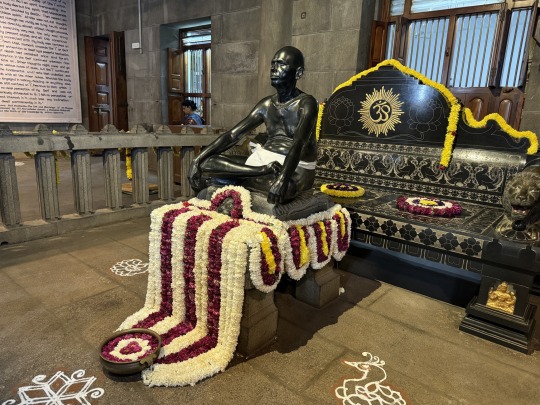
Celebração Jayanti - Evento especial para comemorar o nascimento de Sri Ramana Maharshi (30 de dezembro de 1879 - 14 de abril de 1950)
🌹🌸🌺🌷🙏
145ª Celebração Jayanti de Bhagavan Sri Ramanamaharshi
O 145º Jayanti de Bhagavan Ramana Maharshi foi celebrado com grande devoção e esplendor no dia 17 de dezembro de 2024 no Sri Ramana Ashram.
A auspiciosa ocasião de Ramana-Jayanti foi honrada de uma forma profundamente espiritual e exemplar, começando de madrugada, pelas 4 horas, com recitais cantados. As festividades matinais incluíram 'poojas' especiais (rituais religiosos de veneração), Mahanyasa Rudra 'japam' (repetição de um mantra), o cântico Akshara Mana Malai, e a recitação de Ramana Stuti, todos os quais preencheram a atmosfera de vibrações sagradas, e de reverência pelo venerado Maharshi. À medida que o dia avançava, foi realizado um grande 'abhishekam' (em sânscrito, Abhishekam significa “limpar” ou “purificar”; é um rito religioso ou forma de oração em que um devoto derrama uma oferenda líquida sobre a imagem ou 'murti' da divindade), seguido de uma intrincada decoração floral do santuário, refletindo o profundo amor e respeito que os devotos têm por Bhagavan Ramana. A cerimónia final do 'aarthi' teve lugar por volta das 10h30, após a dedicação de vários cânticos devocionais, marcando o culminar dos rituais matinais. (Em sânscrito, a palavra ‘arti’ – transcrita como ‘aarati’ – é composta pelo prefixo ‘aa’, que significa completo, e ‘rati’, que significa amor. O arti é, portanto, uma expressão do amor completo e inabalável a Deus. É cantado e executado com um profundo sentimento de reverência, adoração e consciência meditativa. Um devoto ou sacerdote move uma lamparina sagrada no sentido dos ponteiros do relógio em frente à divindade.)
A celebração continuou com uma refeição festiva, durante a qual milhares de devotos participaram no 'prasadam' divino (alimento sagrado, purificado - literalmente, 'prasadam' significa a misericórdia do Senhor), partilhando a graça e as bênçãos de Bhagavan. O espírito de comunidade e devoção era palpável à medida que as pessoas se reuniam para honrar os ensinamentos e a vida do Maharshi.
À noite, a atmosfera manteve-se vibrante, impregnada de devoção, elevando ainda mais a santidade deste dia e aprofundando o sentimento da presença de Bhagavan. Toda a celebração foi uma sincera homenagem ao Maharshi, marcada pelo fervor espiritual, pela unidade e pela devoção de todos os presentes.
~ https://www.facebook.com/arunachala.ramana.35/
🙏🌹🌸🌺🌷🕉️ Om Namo Bhagavathe Sri Arunachala Ramanaya 🙏🕉🙏 ❤️🤍🪔🙇♀️

5 notes
·
View notes
Video
youtube
#ramanasramam, #ramanamaharshi, #Ramana, #Muruganar, #ramanamaharshi, #SannidhiMurai, #ramanasramam, #Ramana
ரமண கீதம் Ramaṇa Gītam
சமய மீதுநீ, நிமல வாழ்வுதா அமல வேங்கட,ரமண தேவனே.
samaya mīdunī, nimala vāzhvuthā amala vēṅkaṭa ramaṇa dēvaṉē
This now is the time ! Now give The gift of life, pure bliss, my God, Ramana immaculate
திமிர மாயையைத்,துமிய வெட்டுவாய் அமித வேங்கட,ரமண தேயனே
timira māyaiyait-tumiya veṭṭuvāy amita vēṅkaṭa ramaṇa thēyaṉē
Ramana, lord of light immense, Scatter maya dark, intense
எமனை வென்றதாட், கமல நல்குவாய் இமய மேலுறை,ரமண ஈசனே.
emanai veṇḍṟadāṭ kamala nalguvāy imaya mēluṟai ramaṇa īsaṉē
Ramana, dweller on Himalaya, show The feet that vanquished Yama once
சமன மாய்நின்றாட்,கமல நீழல்வாய் அமர நல்குவாய்,ரமண சாந்தனே
samaṉa māyniṇḍrāṭ kamala nīzhalvāy amara nalguvāy ramaṇa sāntaṉē
In the shadow of those lotus feet, Ramana, lord of peace serene, Let me immortal sit.
குமுத வாயினால்,அமுத மென்மொழி சமுக நின்றுதா,ரமண ராயனே.
kumuda vāyiṉāl amuda meṉmozhi samuga niṉḍṟutā ramaṇa rāyaṉē
Face to face, king Ramana, speak From flower-like lips ambrosial words
கமல மார்புசேர்,தமல மாலைதா எமது வேங்கட,ரமண நாதனே
kamala mārbusēr tamala mālaitā emadu vēṅkaṭa ramaṇa nādaṉē
And Ramana Lord, give in exchange The garland resting on your chest.
குமுத வாயிதழ்,அமுத நல்குவாய் ரமண வேங்கட,அமுத வாயனே kumuda vāyidazh amuda nalguvāy ramaṇa vēṅkaṭa amuda vāyaṉē
Let me drink the nectar sweet From those lilies, your soft lips
விமல வெள்ளிடை,அமளி மீதிலே ரமிய மாவணை,ரமண ராமனே.
vimala veḷḷiḍai amaḷi mīdilē ramiya māvaṇai ramaṇa rāmaṉē
In the clear cosmic space so vast Embrace her warmly, Ramana-Rama
கமக மென்னவே கமழு மென்மலர் அமளி யேறுவாய் ரமண நாதனே
Kamaka meṉṉavē kamazhu meṉmalar amaḷi yēṟuvāy ramaṇa nādaṉē
Ascent this bed of softest flowers Wafting fragrance, Ramana Lord
ஆன்ம னாமுனை,யான்ம ணந்ததே ஆன்ம லாபமென்,ஆன்ம நாதனே
āṉma ṉāmuṉai yāṉma ṇandhadē āṉma lābameṉ āṉma nādaṉē
In wedding you, the Master Self, I gain my own, my Self, again
Translation - Prof. K. Swaminathan
Sangeetha Swaminathan - www.youtube.com/@sangeethaswaminathan9724
1 note
·
View note
Video
youtube
Hridaya Kuhara Madhye 'Sloka Chanting'
🕉️
हृदयकुहर मध्ये केवलं ब्रह्ममात्रम्। ह्यमहमिति साक्षद् आत्मरुपेण भाति॥
हृदि विश मनसास्वं चिन्वता मज्जता वा। पवन चलन रोधाद् आत्मनिष्ठो भव त्वम्॥
hṛdayakuhara madhye kevalaṃ brahmamātram। hyamahamiti sākṣad ātmarupeṇa bhāti॥
hṛdi viśa manasāsvaṃ cinvatā majjatā vā। pavana calana rodhād ātmaniṣṭho bhava tvam॥
🕉️
‘Hridaya-Kuhara-Madhye’, In the centre of the Heart cave
In the centre of the cave which is the Heart, the one (non-dual) Brahman alone shines directly in the form of Self as ‘I-I’ (or ‘I am I’ ). Enter the Heart (by the mind) sinking scrutinizing Self, or by the mind sinking along with the breath, and be one who abides in Self.
~ Ulladu Narpadu - Anubandham (Reality in Forty Verses - Supplement), V. 8
Note: One day in 1915 a devotee named Jagadiswara Sastri started to compose a Sanskrit verse beginning with the words. ‘Hridaya-Kuhara-Madhye’, (In the centre of the Heart cave), but finding that he was unable to proceed any further to express in verse form the idea which he had in mind, he implored Sri Bhagavan to complete the verse for him. Sri Bhagavan accordingly completed the verse and wrote underneath ‘Jagadisan’, thereby indicating that the ideas in the verse were those of Jagadiswara Sastri and not His own. Some years later, at the request of some Tamil devotees who did not know Sanskrit, Sri Bhagavan translated this verse into Tamil, and the Tamil version, which is given above, was later added in the Anubandham.
_____________
Kavyakanta Ganapati Muni also included this verse in his Sri Ramana Gita, ch. II, v. 2.
🕉️
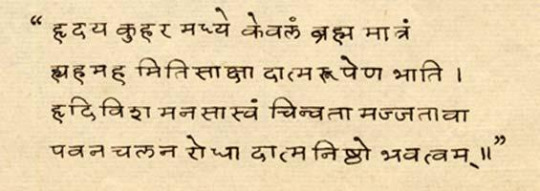
___________________ The Sanskrit verse is a facsimile of Sri Ramana Maharshi’s handwriting reproduced from the manuscript.
___________________
Eka Sloki of Sri Ramana Maharshi, his most important verse, was mounted during Bhagavan´s lifetime, obviously with his consent, above his ornate marble couch in the New Hall, where the verse is engraved in gold Sanskrit letters on a tablet of polished black marble.
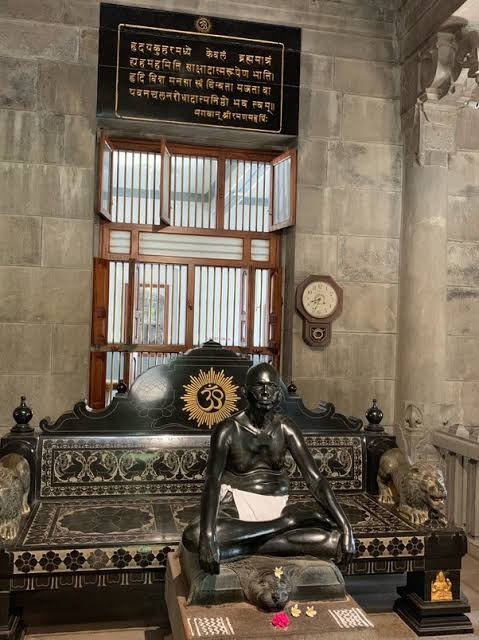
Image credit: https://www.facebook.com/RamanaMaharshi - Post dated 12.06.2020
🕉️
#youtube#Bhagavan Sri Ramana Maharshi#Sri Ramana Gita#B. V. Narasimha Swami#Kavyakantha Ganapati Sastri#Jagadiswara Sastri#Heart#Heart - cavern#hridaya kuhara madhye#self-investigation#self-inquiry#vichara#atma-vichara#Who Am I?#plunge the pure mind into the Heart
7 notes
·
View notes
Text
Arunachala Mountain ✨🔱🕉🔥✨
A Full Trek - From Base to Peak - By Grace of Sri Ramana
youtube
Ram MoanK said:
This is a video of my second trek in the last four years-from the base of Arunachala Hill (from behind Ramanasramam) to the peak of the Hill. On the first day I had to come down after climbing upto Skandasramam because of some issues. The next morning I went up again. This time after climbing more than half way, my camera started having some problem! However being determined to complete the trek and the video, I did some deft work, the result of which is before you. Hope viewers can also enjoy some of my favorite BG Music which I have incorporated in the video.
Audios:
Arunagiri Yogi by JJ and L.Rao
Hari Hara Abheda Dasa Sloki-by JJ
Song on Ramana Naamam by unknown
Instrumental Veena by Rajesh Vaidya
Siva Taandava Stotram by Unknown.
✨🔱🕉🔥✨
9 notes
·
View notes
Text

ॐ
How many are there who have been ruined like me for thinking this Hill to be the Supreme? O men, disgusted with this life of intense misery, ye seek a means of giving up the body; there is on earth a rare drug which, without actually killing him, will annihilate anyone who so much as thinks of it. Know that it is none other than this Arunachala.
— Bhagavan Sri Ramana Maharshi - “Sri Arunachala Padikam” - "Eleven Verses To Sri Arunachala", Verse 11
ॐ
~ Image: ARUNACHALA
My first watercolor, inspired by a photograph of Bernd Kalidas Flory
ॐ
#bhagavan sri ramana maharshi#arunachala#Arunachala Padikam#AP v.11#devotion#bhakti#non-duality#self-surrender#divine grace
10 notes
·
View notes
Text

ॐ
Quantos há que foram destruídos como eu por terem pensado que este Monte é o Supremo? Ó homens, desgostosos desta vida de intenso sofrimento, que buscais um meio de renunciar ao corpo; existe na terra uma droga rara que, sem realmente o matar, aniquilará qualquer um que pense nela. Saiba que não é senão este Arunachala.
— Bhagavan Sri Ramana Maharshi - “Sri Arunachala Padikam” - "Onze Versos Para Sri Arunachala", Verso 11
ॐ
~ Imagem: ARUNACHALA
A minha primeira aguarela, inspirada numa fotografia de Bernd Kalidas Flory
ॐ
#bhagavan sri ramana maharshi#arunachala#Arunachala Padikam#AP v.11#devoção#bhakti#rendição#entrega#não-dualidade#graça divina
6 notes
·
View notes
Text
IN FOCUS - This Month at Sri Ramana Maharshi Ashram - SRI RAMANASRAMAM
youtube
7 notes
·
View notes
Video
youtube
2023-10-28 Ramana Maharshi Foundation UK: Understanding solipsism as taught by Bhagavan Ramana
------------------------
eka-jīva-vāda Means the contention that there is just one jiva, one ego. This is very fundamental in Bhagavan’s teachings; it is implied in so many of Bhagavan’s teachings. For example, this one example out of many, it is implied throughout Uḷḷadu Nārpadu (Reality in Forty Verses), but one place where it is particularly clear is in Verse 26:
If ego comes into existence, everything comes into existence; if ego doesn’t exist, everything doesn’t exist. Ego itself is everything. Therefore, investigating what it is, is giving up everything.
This verse would make no sense if there were multiple egos, because the multiplicity of egos should be part of the «everything» that Bhagavan refers to when he says «If ego comes into existence, everything comes into existence». So, we can make sense of this verse, and so many other teachings of Bhagavan, only if we are willing to accept that a fundamental principle of Bhagavan’s teachings is that there is just one ego. This teaching that there is just one ego is what in western philosophy is referred to a solipsism. However, the solipsism taught by Bhagavan is a very much deeper and more nuanced solipsism. [...]
------------------------
In a Zoom meeting with the Ramana Maharshi Foundation UK on 28th October 2023, Michael James talks about solipsism as taught by Bhagavan, and answers various questions about Bhagavan’s teachings. The analytical set of premises and inferences that he offers for consideration at the beginning this meeting is:
1. We are the experiencer of all that we experience. 2. As the experiencer, we always experience ourself as a person. 3. As the experiencer, we perceive a world that is full of other people, who are just like the person we seem to be. 4. Since we, the experiencer, always experience ourself as a person, every other person seems to us to be an experiencer, just like us. 5. All the other people and their experiences are no less real than the person we seem to be. 6. So long as we seem to be a person, we experience suffering, and every other person seems to us to experience suffering in the same way. 7. So long as we are firmly convinced that this person whom we seem to be is what we actually are, then our suffering and the suffering of all other people will inevitably seem to us to be real.
8. But are we this person? In other words, is this person what we actually are?
9. If this person is not what we actually are, our experience of ourself as ‘I am this person’ is an illusion, and hence unreal. 10. Everything that we (as the experiencer) experience is based upon our experience of ourself as a person, because we experience things other than ourself only when we experience ourself as a person (namely in waking and in dream). 11. Therefore if our experience of ourself as ‘I am this person’ is an illusion, our experience of everything else must be equally illusory. 12. If our experience of everything else is illusory, the person we seem to be and all the other people are a part of that illusion, and hence unreal. 13. If the person we seem to be and all the other people are unreal, their suffering and everything else that they seem to experience must also be unreal. 14. Therefore, since the appearance of multiple experiencers exists in the view of ourself as an experiencer who experiences itself as a person, if we are not this person, then the entire appearance of multiple experiencers is an illusion, and hence unreal. 15. Since there can be no appearance without an experiencer of it, the root cause of the entire appearance of multiple experiencers is the experiencer of it, namely ourself. 16. Therefore, before we can reliably judge the reality of the appearance of multiple experiencers, we first need to investigate and find out the reality of ourself, in whose view all those multiple experiencers seem to exist.
------------------------
7 notes
·
View notes
Text
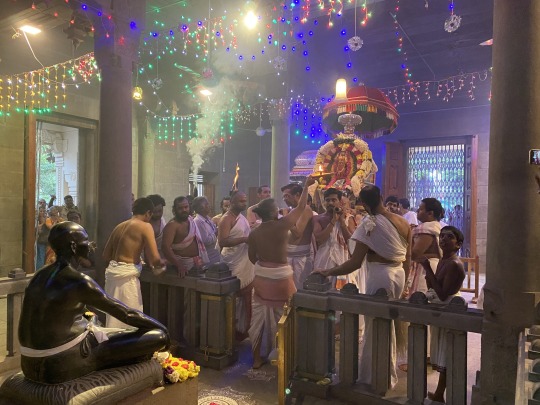
Sri Ramana Maharshi - Sri Ramanasramam
🕉️
Bhagavan is an expert doctor who has precisely diagnosed the root cause of all our problems, namely ego, and he has prescribed the perfect medicine to eradicate this root cause, namely the simple practice of patient and persistent self-investigation and self-surrender.
Therefore, if we want to be benefited by his teachings, our primary duty to ourself is to try our best to subside deep within by patiently persevering in our practice of self-investigation and self-surrender.
When we do so, we will face many obstacles in the form of our viṣaya-vāsanās (inclinations to seek happiness in objects or phenomena), but we should never give up, because as Bhagavan often said, ‘Nobody has ever succeeded on this path without perseverance’. No matter how many obstacles we may face, and how many times we may seem to fail, if we patiently persevere in trying our best to cling firmly to self-attentiveness, by his grace we will surely succeed eventually in sinking back into the innermost depth of our heart, where he shines eternally as the infinitely clear light of pure awareness, waiting like an old lion to devour us as soon as we enter his abode.
~ Michael James, in ✨Ramana Maharshi’s Forty Verses on What Is✨ ✨- The ultimate truth on being as you actually are -✨ A compilation of the writings and talks on 𝖴ḷḷ𝖺𝖽𝗎 𝖭āṟ𝗉𝖺𝖽𝗎 by Michael James. Compiled and edited by Sandra Derksen ✨🔱✨
#Bhagavan Sri Ramana Maharshi#Ulladu Narpadu#Reality in Forty Verses#forty verses on what is#Michael James#Sandra Derksen#self-investigation and self-surrender
12 notes
·
View notes
Text
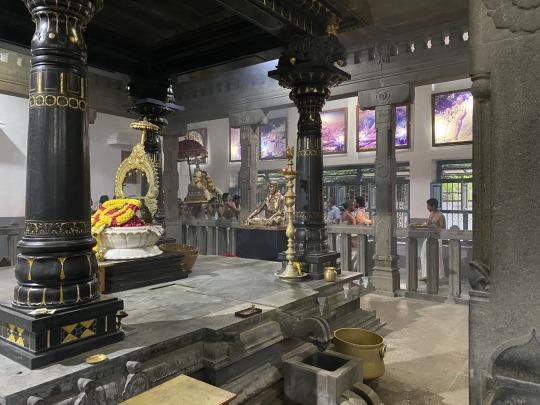
Sri Ramana Maharshi - Sri Ramanasramam
🕉️
Bhagavan é um médico especialista que diagnosticou com precisão a causa raiz de todos os nossos problemas, ou seja, o ego, e prescreveu o remédio perfeito para erradicar essa causa raiz, ou seja, a simples prática da auto-investigação e da auto-entrega paciente e persistente.
Portanto, se quisermos ser beneficiados pelos seus ensinamentos, o nosso principal dever para com nós mesmos é tentar o nosso melhor para mergulharmos profundamente no nosso interior, perseverando pacientemente na nossa prática de auto-investigação e auto-entrega.
Ao fazermos isso, enfrentaremos muitos obstáculos na forma das nossas viṣaya-vāsanās (inclinações para buscar a felicidade em objetos ou fenómenos), mas nunca devemos desistir, porque, como Bhagavan costumava dizer: 'Nunca ninguém teve sucesso neste caminho sem perseverança'. Não importa quantos obstáculos possamos enfrentar, e quantas vezes pareçamos falhar, se perseverarmos pacientemente em tentar o nosso melhor para nos apegarmos firmemente à auto-atenção, pela sua graça certamente conseguiremos finalmente afundarmo-nos de volta nas profundezas mais íntimas do nosso coração, onde ele brilha eternamente como a luz infinitamente clara da pura consciência, esperando como um velho leão para nos devorar assim que entrarmos na sua morada.
~ Michael James, in ✨Ramana Maharshi’s Forty Verses on What Is✨ ✨- The ultimate truth on being as you actually are -✨ A compilation of the writings and talks on 𝖴ḷḷ𝖺𝖽𝗎 𝖭āṟ𝗉𝖺𝖽𝗎 by Michael James. Compiled and edited by Sandra Derksen ✨🔱✨
#Bhagavan Sri Ramana Maharshi#Ulladu Narpadu#Reality in Forty Verses#forty verses on what is#Michael James#Sandra Derksen#self-investigation and self-surrender
3 notes
·
View notes
Text

Om Namo Bhagavate Sri Arunachalaramanaya
🕉️
True love is giving, not taking. If we truly love someone, we will not be concerned about what we can take or gain from them for ourself but only about what we can give to them. So long as we seek to gain anything from God for ourself, our love for him is still impure. If our love for him is pure, we will want nothing but to give ourself entirely to him. Therefore pure bhakti is heart-melting and all-consuming love to give ourself completely and unreservedly to God. Few of us have such bhakti in its fullest form, but if we are following the spiritual path this is what we should be aspiring for and working towards. Complete surrender of ourself to God, the one infinite and eternal reality that always exists and shines in our heart as our own being, ‘I am’, alone is the true and ultimate goal of bhakti.
When we start on the path of bhakti, God seems to be something other than ourself, so we try to express our love for him through actions of body, speech and mind, namely pūjā (worship of him), stōtra (singing his praises) or japa (repetition of his name) and dhyāna (meditation on him) respectively, and by the love with which we do such actions our mind is gradually purified, meaning that it is cleansed of all its inclinations to seek happiness in anything other than love for God, as Bhagavan explains in verses 3, 4-5-6-7 of Upadēśa Undiyār. As our mind is thereby purified, we gain the clarity to recognise that we cannot actually be anything other than God, the one infinite whole, the fullness of being, the only thing that actually exists, so since we have thereby come to understand that he alone is what we actually are, we cease seeking him outside ourself and instead begin to seek him only in the depth of our own heart. That is, instead of meditating on him as something other than ourself, as we were doing previously, we start to meditate on him as none other than ourself, with the clear understanding that he is I.
Since the nature of ourself as ego is to rise, stand and flourish by attending to things other than ourself, we will subside and sink back into the depth of our heart only to the extent to which we attend to ourself alone, as Bhagavan makes clear in verse 25 of Uḷḷadu Nāṟpadu, so by meditating on ourself we are surrendering ourself to God, and hence in verse 8 of Upadēśa Undiyār he says that ananyabhāva, meditating on nothing other than ourself, is ‘அதனத்தினும் உத்தமம்’ (aṉaittiṉum uttamam), ‘best among all’, implying that it is not only the best practice of bhakti and most effective means to purify the mind but also the only means by which we can eradicate ego and thereby surrender ourself completely to God. Since we as ego will subside back into our being to the extent to which we attend to ourself, when by persistent practice our self-attentiveness becomes strong and stable enough, we will thereby be firmly fixed in our true state of being (sat-bhāva), which transcends all mental activity, so being in this state is para-bhakti tattva, the true state of supreme devotion, as Bhagavan says in verse 9 of Upadēśa Undiyār, because it is the state in which we have given ourself wholly to God and therefore do not rise as ego to know anything other than ourself.
The path of bhakti is therefore a gradual progression towards this state of complete self-surrender, as also is the path of jñāna, so the goal of both these paths is identical, even though the followers of each may describe it in different terms. What is called complete self surrender in the path of bhakti is what is called eradication of ego and consequent removal of avidyā in the path of jñāna. If we go deep in following either of these paths, the superficial differences that others see between them will dissolve and disappear, and we will clearly recognise that they are one and inseparable, not only in their ultimate goal but also at deeper levels in their practice.
~ Michael James, in ✨Ramana Maharshi’s Forty Verses on What Is✨ ✨- The ultimate truth on being as you actually are -✨ A compilation of the writings and talks on 𝖴ḷḷ𝖺𝖽𝗎 𝖭āṟ𝗉𝖺𝖽𝗎 by Michael James. Compiled and edited by Sandra Derksen ✨🔱✨
#Bhagavan Sri Ramana Maharshi#Ulladu Narpadu#Reality in Forty Verses#forty verses on what is#Upadesa Undiyar#Michael James#Sandra Derksen#bhakti devotion#path of self-surrender#path of jnana
6 notes
·
View notes
